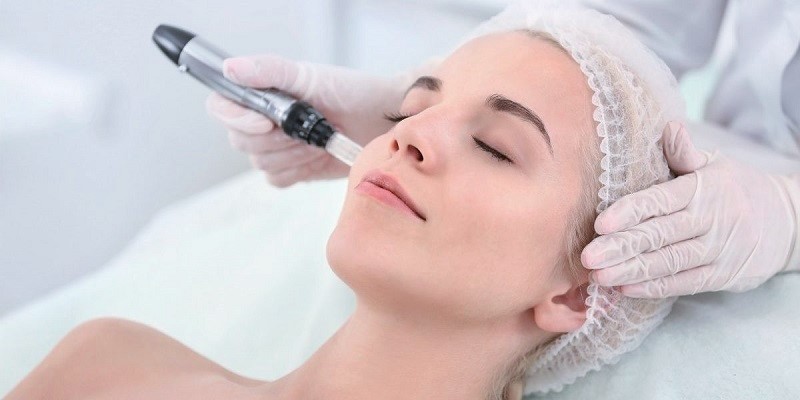Introduction
Microneedling is a type of rejuvenation technique. It is also known as collagen induction therapy or percutaneous collagen induction. This technique can be used with or without conjunctive therapies to reduce the appearance of facial aging.
Facial Aging
In normal aging, also known as intrinsic, the skin becomes increasingly loose. With more cell turnover, it loses its natural regenerative capacity. This loss is particularly prevalent in the deepest layer. This layer is the connective tissue layer, which holds everything together. The collagen and proteins in the skin lose their tight connections, leading to increased loosening of the skin on a molecular level. Pigment cells, also called melanocytes, also decrease with age, causing patchy skin pigmentation.
Extrinsic aging refers to aging secondary to other factors rather than the body’s natural processes. The biggest offender is the sun. Ultraviolet radiation (UV) affects the skin. UV-B rays affect the top layer of the skin. These rays are then absorbed into the DNA of cells, which then damages the external barrier and pigment cells, leading to sunburn, immunosuppression, and cancer.
Treatment Options
There are multiple treatment options to reduce the signs of facial aging. These include topical treatments like sunscreen, Vitamin C, and retinoids, energy-based treatments like lasers, injections, and surgery.
Microneedling
Microneedling has been popular since the 1990s. It uses a drum-shaped instrument with very small needles. These needles puncture the skin through both layers. These wounds cause the skin to heal itself and regenerate. This then causes increased elastic fibers, collagen, and increased skin thickness. The collagen that forms lays in its normal pattern, called a lattice. Collagen is the tissue that is responsible for the tighter appearance of younger skin. This is unlike scarring, which lies in parallel bundles. Scientists can see under the microscope that skin generated by microneedling is identical to normal skin and is unlike scars. Doctors have found that microneedling can also be useful for people with acne scars, suboptimal skin texture, hypertrophic or burn scars on the body, and alopecia.
Platelet-Rich Plasma
Platelet-Rich Plasma (PRP) is a newer technology. Normal whole blood is comprised of red blood cells, platelets, and plasma. Platelets are tiny cells found in the blood that cause clotting. When someone gets a cut, platelets are what clump together to stop the bleeding. Plasma is the “liquid” of the blood, essentially everything but the platelets and blood cells. Altogether, PRP is the plasma with the platelets only. PRP contains all of the growth factors found in blood.
These factors are responsible for regenerating things in the body like cells, blood vessels, and
skin cells.
Microneedling with PRP
With the benefits of PRP and microneedling individually, in theory combining these therapies should have even greater effects on anti-aging. There have been several studies that have studied microneedling with and without PRP.
Patients with Acne Scars
Study 1
In the first study, there were 50 patients. Their average age was 25.7 years old. In those who had microneedling with PRP, there was a 62% improvement in scarring. In those who used microneedling without PRP, there was a 46% improvement in scarring. There were no long- term adverse effects.
Study 2
There were only 12 participants in this study, and their average age was 32.3 years old. In those patients who received both microneedling and PPR, there was a 47% improvement in scarring. In those who received microneedling alone, there was a 35% improvement. There were no long-term adverse effects. Notably, this study used more passes of the microneedle but had fewer treatments (10-14 passes in 4 directions, 2 treatments in 8 week intervals vs. 6 passes in 4 directions, 3 treatments at 1 month intervals in the first study).
Study 3
In this study, there were 30 participants who were 27.5 years of age on average. In those who had microneedling with PRP, there was an excellent response in 78% of the patients. Those who had microneedling but no PRP also had vitamin C in this study. In those patients, there was a 65% excellent response. In this study, one patient experienced post-inflammatory hyperpigmentation. It is important to note that this study had a different amount of passes and treatments that the previous two. In this study, there were 8-10 passes of the microneedles in 4 directions. They were 4 treatments at 1 month intervals.
Conclusion
In all, these 3 studies show that microneedling can improve the appearance of skin, even in younger people. These results suggest that an increased number of treatments or passes has an increased benefit. These results also show that microneedling alone has a benefit, but that benefit increases with PRP.
There are many options to combat aging. At the Anti Aging and Wellness Clinic, we have developed state-of-the-art treatment protocols to address aging. If you are interested in learning more about how you can use this technology for your own health goals, please contact our clinic today.








